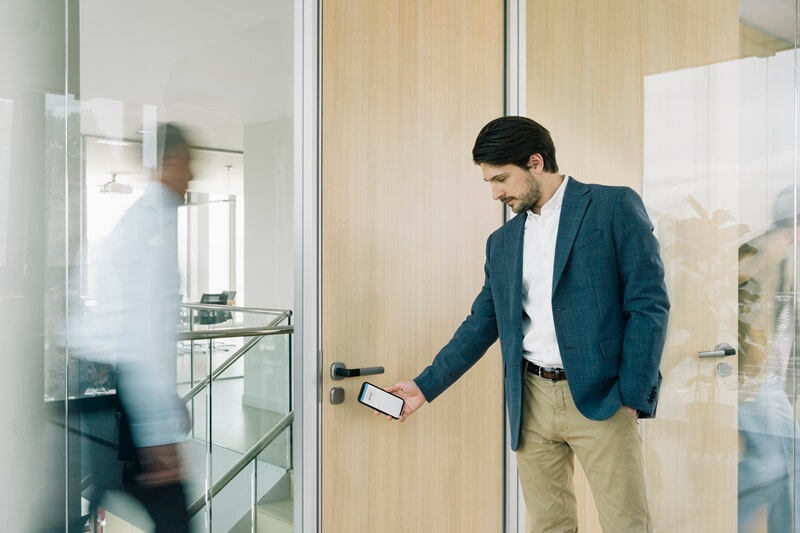In business and personal life today, digitalization increasingly means moving to mobile. We speak to David Moser, SVP & Head of Digital Access Solutions at ASSA ABLOY Opening Solutions EMEIA, about the benefits – now and in the future – of mobile access.
In business and personal life today, digitalization increasingly means moving to mobile. We speak to David Moser, SVP & Head of Digital Access Solutions at ASSA ABLOY Opening Solutions EMEIA, about the benefits – now and in the future – of mobile access
Q: What are some of the growth drivers for mobile access control?
 David Moser, SVP & Head,
David Moser, SVP & Head,
Digital Access Solutions,
ASSA ABLOY Opening
Solutions, EMEIA
Mobile-first is fast becoming the norm across regions and industries. In Western Europe for example, there are currently around
459 million active smartphones. Only a fraction of these are currently used for digital access. The situation is changing fast, however:
one projection suggests mobile credentials’ CAGR of more than 22 percent over the next 7 years. This rapid growth seems only natural. In terms of access management, it is more secure and more convenient, for both building users and managers, when the smartphone doubles as a key. At ASSA ABLOY, we were very quick to spot the benefits of mobile access for all kinds of stakeholders.
Q: How does mobile access control benefit users, administrators and business owners?
From an ownership perspective, digitalization helps to maximize the productivity of existing assets. By adopting a mobile ethos, businesses boost user convenience and building security. Using mobile keys for access helps staff to act faster, work smarter and collaborate better. With mobile access, staff and visitors no longer need to carry or keep track of keys, fobs, badges or cards. It’s much more convenient. From a facilities management perspective, mobile access enables the secure movement of people into and through premises. It streamlines daily site admin work. Mobile credentials are easier for security managers to amend or de-authorize than a mechanical key. Remote access management via smartphone and a secure cloud also saves facilities staff time and hassle. They work more flexibly, benefitting their well-being and their organization’s productivity.
 Q: What security features are included in modern mobile access control solutions to ensure that unauthorized users cannot hack or bypass the system? How is user privacy protected?
Q: What security features are included in modern mobile access control solutions to ensure that unauthorized users cannot hack or bypass the system? How is user privacy protected?
The security of a mobile credential is one of its most important advantages. For one, biometrics are built into almost every modern smartphone via fingerprint or face ID unlocking. According to
Apple, the chance a random person can unlock your device with Face ID is under one in a million. Mobile credentials can be amended over the air, without any delay in waiting for the credential holder to visit a reader or updater. When a security administrator cancels a mobile key, it vanishes immediately from a user’s phone. Human behavior is also on the security manager’s side. How quickly would an employee notice their plastic access card was missing? Everyone is more careful with their handset. Facilities staff are frustrated when users lend or share credentials: fewer people are willing to pass on their phone, even for 5 minutes. Of course, the move to mobile and digital requires a holistic approach to security from manufacturers, too. At ASSA ABLOY, for example, the ecosystem now extends beyond product manufacturing and testing to incorporate the supply chain for components, secure coding practices and, where relevant, the cloud management environment – including the encrypted connection between client mobile and cloud server.
Q: What are some of the vertical markets that can benefit most from mobile access control? Why?
Multi-residential housing is one sector, among many, where the advantages of mobile access have seen its rapid growth. One of our customers, Becorp, planned new build-to-rent development in Barcelona and sought a digital alternative to mechanical keys. Becorp realized a keyless solution would save property management time, which is often spent handling hundreds of physical keys. The burden on staff is especially great when properties are newly occupied or vacated, a regular occurrence in build-to-rent complexes. They chose SMARTair, our out-of-the-box wireless digital access solution, to equip apartment doors and common areas. Residents use secure mobile keys in their own secure SMARTair Openow app. It saves time and hassle for everyone, and therefore costs for Becorp.
This is just one example, from one industry. We have helped organizations of almost every size and type to benefit from mobile access. Offices, education institutions, commercial sites, public buildings. Almost any sector you can think of. Everyone carries a mobile phone.
Q: How do you see the future of mobile access control?

Offering choice is going to be increasingly important. There is no “one-size-fits-all” mobile solution. Customer organizations are complex. They have different goals, targets, local regulatory environments and so on. Of course, convenience, security, usability and efficiency are shared goals, too. ASSA ABLOY offers customers mobile access solutions, for both iOS and Android, both within complete digital access systems and via devices which plug seamlessly into an existing security management solution, extending the reach of their digital access management capability. With these solutions, mobile access should be completely customizable, with APIs and SDKs for smartphone app development. Mobile will become part of so many businesses, not just a security add-on.
Q: Please introduce your mobile access control solution. What makes it unique and stand out from others? What sectors is it most suitable for?
As well as SMARTair, which I mentioned earlier, we have CLIQ Connect, a mobile extension to ASSA ABLOY’s CLIQ and eCLIQ programmable key access solution. A keyholder no longer needs to update access rights physically in person. Their system administrator simply opens the CLIQ Web Manager – from anywhere – and updates it. The key-holder makes an encrypted connection between their programmable BLE key and the app to instantly update permissions from the cloud. This solution is especially suited to businesses with remote sites, mobile workforces, employees and contractors who are always on the move. It saves them time and expense spent travelling to update or retrieve keys.
Mobile access is also built-in to ASSA ABLOY digital access devices designed for seamless integration with existing systems. Battery-powered Aperio locks are compatible with both Bluetooth and NFC mobile wireless protocols. Aperio also supports employee badge in Apple Wallet, enabling quick, convenient entry to doors, cabinets, lockers, server racks and more equipped with Aperio wireless devices. ABLOY CUMULUS is another keyless access solution built for integration. With ABLOY CUMULUS, the user’s personalized, encrypted mobile credential is issued directly on their smartphone. In addition, our revolutionary CUMULUS Controller brings mobile unlocking via Bluetooth to any electric or electronic lock – from any brand. The possibilities with mobile are really exciting.
To learn more about Mobile Access Solutions from ASSA ABLOY, visit
https://www.assaabloy.com/group/emeia/solutions/topics/access-control
For more information please contact:
Thomas Schulz
Director & Head of Marketing DAS EMEIA
B2B PR & Media Relations EMEIA
ASSA ABLOY Opening Solutions EMEIA
Phone: +49 (0) 30 8106 2970
E-mail:
thomas.schulz@assaabloy.com